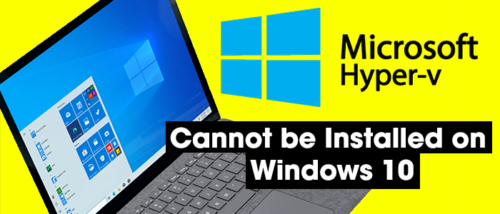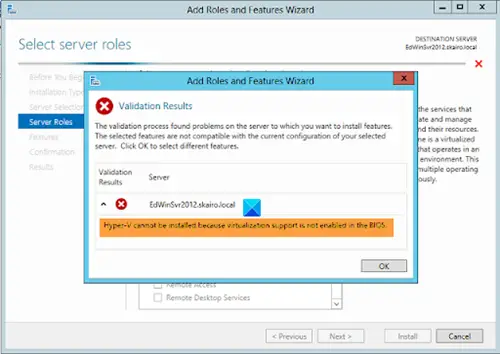Some users of Windows 10 are reporting that they cannot install Hyper-V. If you are also facing the same issue where you are seeing a Hyper-V cannot be installed error, this guide will help you resolve it, and then you can install it normally and use it.

Hyper-V is a virtualization platform that is created by Microsoft, which was introduced with Windows Server. Later, it is made available for Windows 8 and Windows 10 users. Using Hyper-V, you can create multiple virtual systems and use them on a single physical server with ease. All you need is a great physical server that supports your needs. You can manage all the virtual systems using Hyper-V Manager.
So, if you are feeling that you are missing out on this great platform due to the error, follow the fixes we mentioned in this guide and solve the error. Let’s see what are the possible fixes and how we can implement them.
Hyper-V cannot be installed on Windows 11/10

These are the possible fixes that can let you fix the error and install Hyper-V easily.
- Check for System Requirements
- Enable virtualization support in BIOS/UEFI
- Check the integrity of Hyper-V ISO
- Uninstall any other Virtualization Platforms
- Disable antivirus or VPN
Let’s see the fixes in detail and fix the issue.
1] Check for System Requirements
There are certain system requirements that need to be fulfilled if you want to install and run Hyper-V on your Windows 10. The following are the system requirements to install Hyper-V:
- Windows 10 Pro or Enterprise 64-bit Operating System
- 64-bit processor with Second Level Address Translation (SLAT)
- 4 GB system RAM at minimum
- CPU support for VM Monitor Mode Extension (VT-x on Intel CPU’s)
- BIOS-level Hardware Virtualization support
Make sure your system info matches or surpasses the requirements. Also, Hyper-V cannot be installed on Windows 10 Home or Mobile edition. You need to upgrade your system to meet the above requirements and then try to install Hyper-V.
2] Enable virtualization support in BIOS/UEFI
Check if Virtualization support is disabled in your firmware. If so, you need to enable virtualization support in BIOS/UEFI.
3] Check the integrity of Hyper-V ISO
If the ISO file you are using to install Hyper-V is corrupted or any files are missing, then you may encounter the issue. Make sure Hyper-V ISO is devoid of any file corruptions or missing. Download another copy of Hyper-V from microsoft.com and try installing it.
Related: Virtual Machine Management is not present on this machine.
4] Uninstall any other Virtualization Platforms
Check if any other virtualization platform like Kubernetes, or Virtual Box, or any other program running on your Windows 10. If you find any other program running, uninstall them, because you cannot install a virtualization platform like Hyper-V on another virtual machine (which was created by another virtualization software). After you uninstall the third-party virtualization program, you can install Hyper-V without any hassle.
5] Disable antivirus or VPN
Some users who faced similar issues were able to install Hyper-V easily after disabling antivirus or VPN application that is running on their Windows 10. They interfere in the installation process and might result in the error. It is better to disable them completely until the installation is done.
These are the possible fixes that can help you install Hyper-V without any hassle. If you have some other issues with the installation of Hyper-V, do let us know through the comments section.